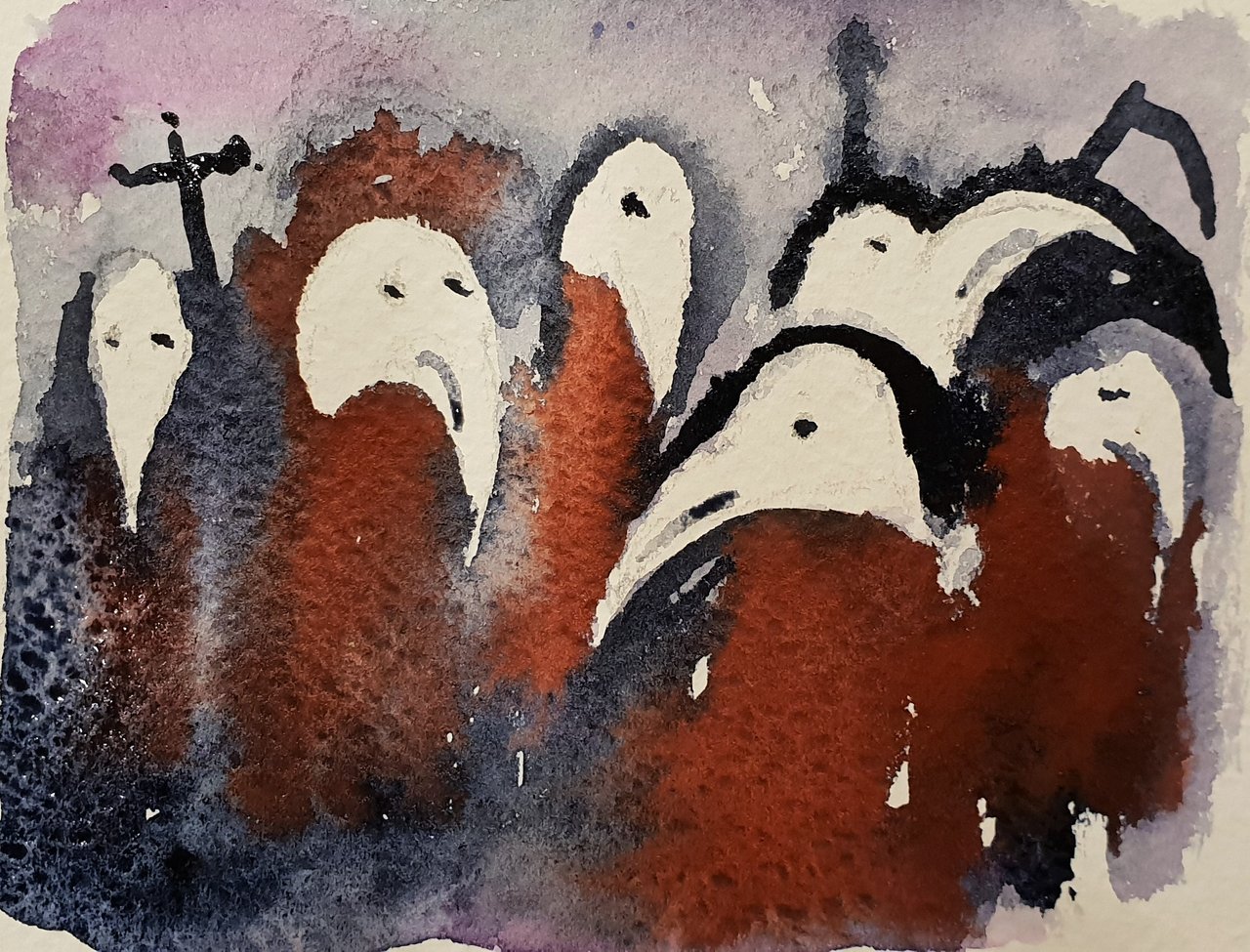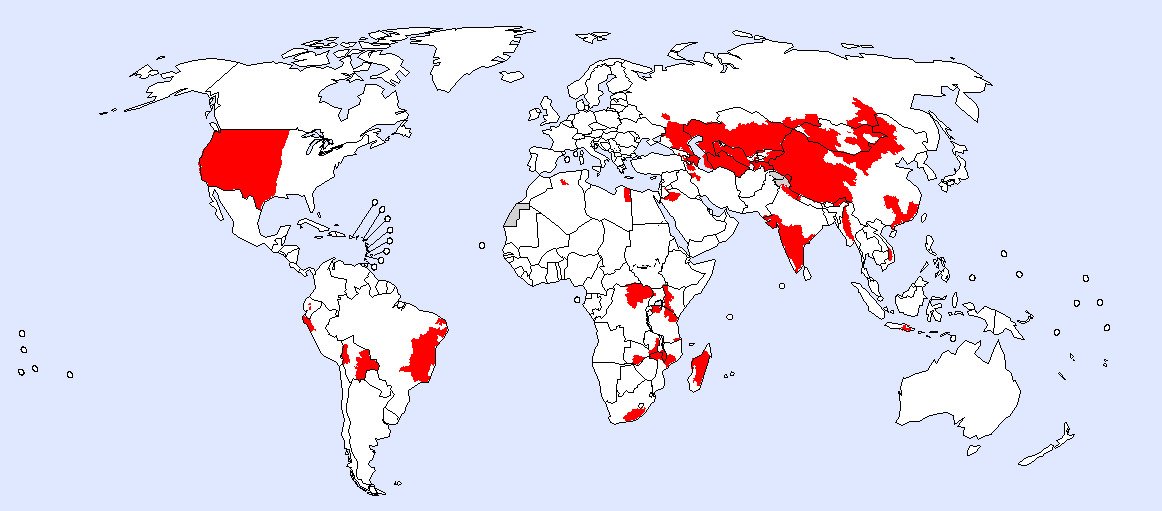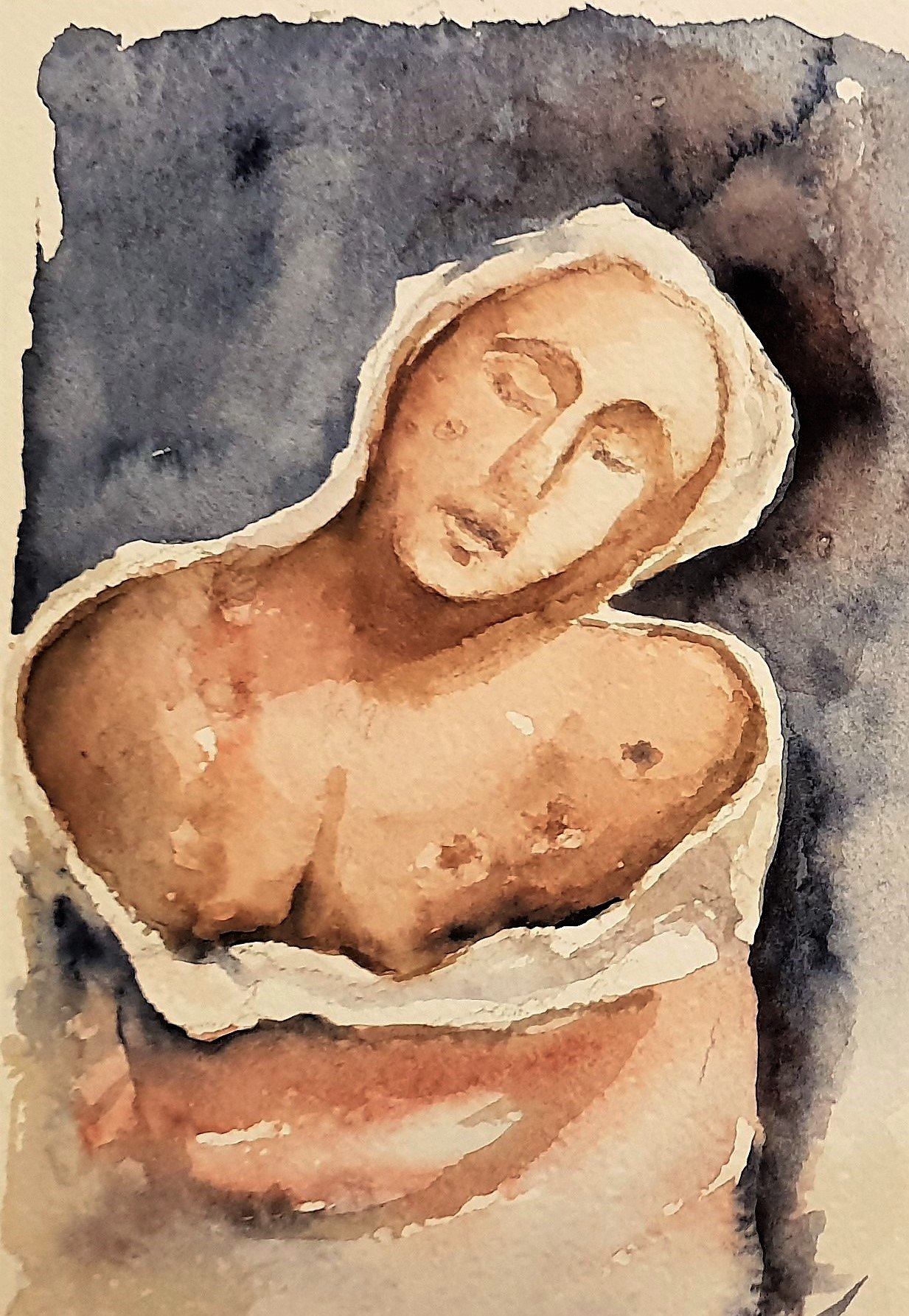
the doctors of the plague

2 0 1 8
watercolor on paper
The doctors of the plague from the fourteenth century began to wear some particular and disturbing beak masks tied to the nape by two laces. The mask had two openings covered by lenses, for the eyes and one for the nose.
It had a respiratory function and inside the large curved beak were placed fragrant substances such as lavender, thyme, myrrh, mint leaves and camphor, cloves, garlic all covered with sponges soaked in vinegar.
I medici della peste a partire dal XIV secolo cominciarono ad indossare delle particolari ed inquietanti maschere a becco legato alla nuca da due lacci.La maschera aveva due aperture coperte da lenti, per gli occhi ed una per il naso.
Essa aveva una funzione di respiratore ed all'interno del grande becco ricurvo erano collocate delle sostanze profumate come la lavanda, il timo, la mirra, foglie di menta e canfora, chiodi di garofano, aglio il tutto coperto da spugne imbevute di aceto.


a look

2 0 1 8
watercolor on paper
THE BLACK DEATH
In Europe, between 1347 and 1353, the Yersinia Pestis bacterium caused the greatest epidemic in the history of the old continent. It is thought that more than a third of the European population was exterminated by the plague also called Great Death or Death Star.
The term "black death" comes from the Latin is atra mors where for the adjective ater it is the meaning of "atrocious, dark" and in the Middle Ages it was called "great pestilence",
It is estimated that the plague reaped a pandemic in Europe between 70 and 100 million victims if we consider that at that time the population was about 350/375 million.
According to recent research conducted by archaeologist Carenza Lewis, of the University of Lincoln, the Great Death could have caused the disappearance of half of the inhabitants of Europe.
The study was based on more than 2000 stratigraphic excavations on cocci of domestic use, the most reliable for this type of research, well identifiable by color, carried out in areas of Great Britain inhabited at the time of the epidemic, the analysis of the remains of pottery of domestic use, present in the upper layers, in the decades following the passage of the black plague, gave a presence of the same findings of less than 50% in some cases to 85%, not counting the villages disappeared following the passage of the epidemic. If this investigation is correct, it could show that the number of deaths is considerably higher than estimated so far. [1
The name that was coined at that time was bubonic plague due to an inflammation and consequent painful swelling of the lymph nodes, due to the buboes that assumed a blackish and repugnant.
The bubonic plague was the watershed of the history of Europe, destroying entire cities forever and distorting the continent's economic and social system. The medieval man was convinced more and more that it was a curse of God rained on Earth, punishment of sins, and also Pope Clement VI and other ecclesiastic characters, organized pilgrimages and collective prayers, doing nothing but rising fast the spread of the bacterium.
The term quarantine, was coined precisely in this period, when the port cities, Venice in the first place, forced the ships to a halt for 40 days.
Solution that practically had no advantage because often the ships changed course and landed in other ports of neighboring cities that ignored or underestimated the danger of contagion. For example, the port of Marseille with its permissiveness contributed to the spread of the Yersinia Pestis bacterium in France and Spain.
A group of researchers has come to a conclusion that could rewrite history. Not the black rats were the vehicle for spreading the plague, but a subfamily of rodents called gerbils present in almost all of Africa, the Middle East, the Arabian Peninsula, in Central Asia, central-northern China and western India.
The spread would take place through the silk road, favored by the very poor hygienic conditions of cities and famines, factors of crisis fed and increased by the cold wave in the European continent.
At that time the climate in Asia was extremely favorable to the proliferation of bacteria in the gerbils and fleas, hot and torrid summers alternated with rainy winters favored its development from the east and consequently continuous exports of gerbils in Europe that took place in merchant ships. So the disease appeared in waves in the old continent, through trade and trade routes, a continuous reimportation of the Yersinia pestis along the Silk Road.
This explains why the plague has remained on the European continent for over four centuries, and the continuous trade with the east has globalized the disease, renewing it continuously, alternative thesis to that supported until 2015, namely that tanks of rats present in Europe contributed to the spread of the infection and for this reason had persisted for so long.
From the team of Nils Christian Stenseth, DNA analyzes of the plague bacteria taken from skeletal devices of various dates across Europe are underway and if there is some variability in the genetic material, the differences from a "conserved" strain would be demonstrated. belonging only to European rats and open a much wider scenario in which the Asian gerbils would be involved, and the proliferation of fleas, favored by the particularly suitable climate in the east.
The study would have important developments to eradicate those hundreds of cases of outbreaks, some mortal, which are still present in the world today. [5]
We await with great interest the results of the DNA tests of the various samples taken between 2015 and 2016 in Europe, which will confirm or counter the thesis of the gerbils and of the climate factor.
Source:
2.Human ectoparasites and the spread of plague in Europe during the Second Pandemic



old report from 2009
vecchio rapporto del 2009.

report on cases of plague updated to 2017.
rapporto sui casi di peste aggiornato al 2017.
These reports show that the phenomenon of the Plague is not at all eradicated and leaves us to reflect on the possibility of greater recrudescence with the climate change, such as heavy rains and long periods of drought.
Even a famous newspaper reports an increase in cases of plague.
Questi report dimostrano che il fenomeno della Peste non è per niente debellato e ci lascia riflettere sulla possibilità di recrudescenze maggiori con i cambiamenti climatici, quali forti piogge e lunghi periodi di siccità.
Anche un famoso giornale segnala un aumento dei casi di peste.


the end

2 0 1 8
watercolor on paper

LA MORTE NERA
In Europa, tra il 1347 e il 1353, il batterio Yersinia Pestis causò la più grande epidemia della storia del vecchio continente. Si pensa che più di un terzo della popolazione europea venne sterminato dalla peste chiamata anche Grande Morte o Morte Nera.
Il termine “morte nera” viene dal Latino cioè atra mors dove per l’aggettivo ater è il significato di “atroce, oscuro” e nel medioevo venne chiamata “grande pestilenza”,
Si calcola che la peste mieté in Europa tra i 70 e i 100 milioni di vittime una pandemia se consideriamo che a quel tempo la popolazione era di circa 350/375 milioni.
Secondo una recente ricerca condotta dall’archeologa Carenza Lewis, dell’Università di Lincoln, la Grande Morte potrebbe aver causato la scomparsa della metà degli abitanti europei.
Lo studio si è basato su oltre 2000 scavi stratigrafici su cocci di uso domestico, i più attendibili per questo tipo di ricerca, ben identificabili per colore, effettuati in zone della Gran Bretagna abitate ai tempi dell’epidemia, l’analisi dei resti del vasellame di uso domestico, presente negli strati superiori, nei decenni successivi al passaggio della peste nera, ha dato una presenza degli stessi reperti inferiore al 50% in alcuni casi al 85%, senza contare i villaggi scomparsi in seguito al passaggio dell’epidemia. Se questa indagine risultasse corretta potrebbe dimostrare che il numero di morti sia notevolmente superiore a quanto stimato fino ad ora.[1
Il nome che venne coniato al quel tempo fu di peste bubbonica dovuto a un’infiammazione e conseguente rigonfiamento doloroso dei linfonodi, per l’appunto bubboni che assumevano un coloro nerastro e ripugnante.
La peste bubbonica fu lo spartiacque della storia dell’Europa, distruggendo per sempre intere città e stravolgendo il sistema economico e sociale del continente. L’uomo medievale si convinse sempre di più che fosse una maledizione di Dio piovuta sulla Terra, a punizione dei peccati, e anche il papa Clemente VI e altri personaggi dell’ecclesia, organizzarono dei pellegrinaggi e preghiere collettive, non facendo altro che aumentare velocemente il diffondersi del batterio.
Il termine quarantena, fu coniato proprio in questo periodo, quando le città portuali, Venezia in primis, obbligavano le navi ad una sosta in rada per 40 giorni. Soluzione che praticamente non aveva alcun vantaggio perchè spesso le navi cambiavano rotta e approdavano in altri porti di città vicine che ignoravano o sottovalutavano il pericolo di contagio. Ad esempio il porto di Marsiglia con il suo permissivismo contribuì al diffondere del batterio Yersinia Pestis in Francia e Spagna.
Un gruppo di ricercatori è giunto ad una conclusione che potrebbe far riscrivere la storia. Non sono stati i ratti neri il veicolo di diffusione del contagio della peste, ma una sottofamiglia di roditori chiamati gerbilli presenti in quasi tutta l’Africa, Medio Oriente, Penisola Arabica, in Asia centrale, Cina centro-settentrionale e India occidentale. La diffusione sarebbe avvenuta attraverso la via della seta, favorita dalle scarsissime condizioni igieniche delle città e dalle carestie, fattori di crisi alimentate e incrementate dall’ondata di freddo nel continente europeo.
In quell’epoca il clima in Asia era estremamente favorevole al proliferarsi dei batteri nei gerbilli e pulci, estati calde e torride alternate ad inverni piovosi ne favorirono lo sviluppo dall’oriente e di conseguenza continue esportazioni di gerbilli in Europa che avvenivano in navi mercantili. Quindi la malattia si presentava ad ondate nel vecchio continente, attraverso scambi e rotte commerciali, un continuo reimportare della Yersinia pestis lungo la Via della Seta.
Ciò spiega perché la peste è rimasta per oltre quattro secoli nel continente europeo, e i continui scambi commerciali con l’oriente ne hanno globalizzato la malattia, rinnovandola in continuazione, tesi alternativa a quella sostenuta fino al 2015, e cioè che serbatoi di ratti presenti in Europa contribuissero alla diffusione del contagio e per tale motivo avesse persistito per così lungo tempo.
Da parte del team di Nils Christian Stenseth sono in corso le analisi del DNA dei batteri della peste prelevati da apparati scheletrici di varie datazioni in tutta Europa e se nel materiale genetico dovesse risultare una certa variabilità, sarebbero dimostrate le differenze da un ceppo “serbato” appartenente solo ai ratti europei ed aprire un ben più ampio scenario in cui sarebbero coinvolti i gerbilli asiatici, e la proliferazione delle pulci, favoriti dal clima particolarmente idoneo in oriente.
Lo studio avrebbe importanti sviluppi per debellare quei centinaia di casi di focolai, in parte mortali, che ancora oggi sono presenti nel mondo.
Aspettiamo con grande interesse il risultato degli esami del DNA dei vari campioni prelevati tra il 2015 e il 2016 in Europa, che potranno avvalorare o controbattere la tesi dei gerbilli e del fattore clima.
Fonti:
2.Human ectoparasites and the spread of plague in Europe during the Second Pandemic



discovery-it
@discovery-it

Vieni a trovarci sulla prima rivista dedicata al mondo dell'arte&storia

